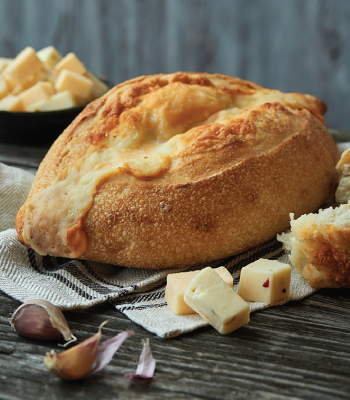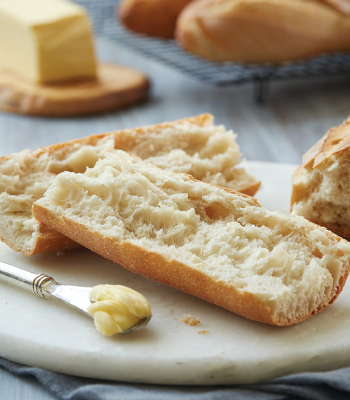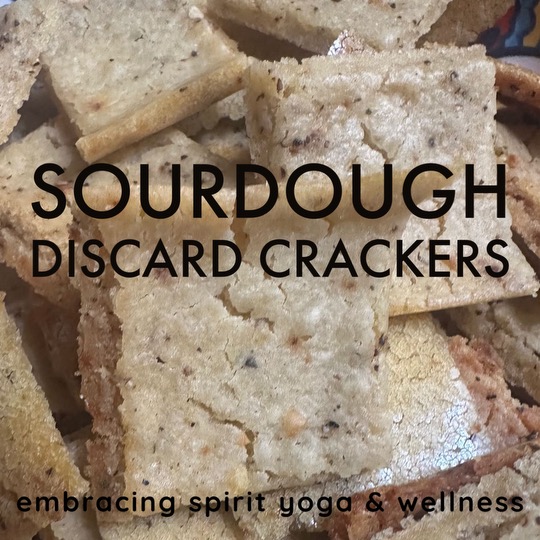Ever since I shared some sourdough discard crackers over on my instagram I have had a zillion questions about them. If you haven’t jumped into the sourdough craze you are definitely missing out. I will admit that at first it seemed like a LOT of work and time, but it really isn’t. I mean how much time do we spend mindlessly scrolling when we could spend a tiny bit of time eliminating garbage from our diet and making something soulful and delicious?
Before I share the super simple cracker process, let’s chat about sourdough.
What is sourdough?
Sourdough relies on a mix of wild yeast and lactic acid bacteria, rather than baker’s yeast, to leaven the dough. It’s richer in nutrients, less likely to spike your blood sugar, contains lower amounts of gluten, and is generally easier to digest than bread made with baker’s yeast.
Store bought bread has so many ingredients in it and most of them are useless ingredients that just add junk to our food. Homemade sourdough is flour, water, salt. Three ingredients compared to over twenty in a store bought version. Hmmm.
By using a special starter of wild yeast and bacteria, the positives of consuming sourdough far outweigh the negative ideas that we should be avoiding bread. Sourdough bread is a baking art form that is, by its very nature, a healthier choice – according to A Bread Affair in Vancouver here are the reasons why…and have to agree 100%.
The Benefits of Sourdough:
1. It is easy to digest.
The bacteria-yeast composition will start to breakdown the starches found in the grains before it even reaches your stomach. That means there is way less work to be done, making it much easier on your gut.
2. It has a lower glycemic index.
Compared to many other types of bread, sourdough is fermented in a way that depletes bad starches within it. This means that it won’t cause your blood sugar to rise so drastically upon eating it.

3. Better for gluten-sensitivity.
The longer prep time for sourdough bread means that much of the protein gluten is broken down into amino acids before you consume it. The extensive soaking, rinsing, and other preparation steps means that it is easier to eat and digest, especially if you have mild sensitivities to gluten.
4. More “good acid”.
Lactobacillus a kind of bacteria found in sourdough bread more so than other types of bread and it results in higher levels of lactic acid. This is important because it means there is less room for phytic acid, which can be potentially dangerous. Larger quantities of lactic acid also result in easier digestion and accessibility to more minerals.
5. Provides healthy bacteria.
Sourdough bread is fermented in a way that fosters more beneficial bacteria in the bread and in your body when you eat it.
6. Less yeast.
Healthy bacteria in sourdough bread works to reduce yeast populations, so the likelihood of infection and/or overgrowth is substantially lower.
7. Natural origins.
Sourdough bread made with whole flour, wild yeast and bacteria comes from a very “natural” origin. It is the oldest form of leavened bread; we have been eating it as part of a natural diet for a long, long time.

8. Fewer preservatives.
Sourdough bread contains acetic acid, which naturally prevent the growth of mold. It naturally preserves itself, meaning that toxic preservatives are not required to make it last. So it won’t go bad – and you can opt out of the hazardous build-up of preservatives in the food supply chain.
9. Good fuel.
Made from wheat, sourdough bread fuels the production of good bacteria in your gut – much like the inulin and oligosaccharides found in onions, leeks, bananas, garlic, asparagus, and so on.
10. It’s nutritious.
Sourdough contains a variety of vitamins and nutrients, making it super beneficial to your day-to-day health. Sourdough bread has small to moderate amounts of: iron, manganese, calcium, B1-B6, B12, folate, zinc, potassium, thiamin, niacin, riboflavin, selenium, iron, manganese, magnesium, phosphorus, and vitamin E. What a great selection! Compared to other breads, sourdough maintains many of the original nutrients that are processed out of other kinds of bread.
11. The taste!
Sourdough bread tastes great on top of being a healthier alternative. What more could you want?
Crackers?? You got it! I also use sourdough to make all kinds of fun things like pizza dough, pancakes, cookies and this weekend I am making English muffins!
First, you’ll need some sourdough “starter”. This consists of flour and water that becomes the base for your bread and other baked goods.
Simply put: a sourdough starter is a live fermented culture of fresh flour and water. Once combined, the culture will begin to ferment and cultivate the natural yeasts found in our environment. A small portion is added to your bread dough to make it rise. Commercial yeast IS NOT required.
The Process of Sourdough:
At first I felt overwhelmed with having to “feed” something and initially wondered if I had a new child to worry about but realized I was way over thinking it.There are some sourdough people out there that measure everything to to the gram and while that does produce a perfect loaf, after awhile you do learn to eyeball things, especially feeding the starter. I usually just pour some out into my discard jar and add 1/2 cup flour and 1/4 cup water and call it good for the week. The day before I bake bread I do feed her a twice so she is extra happy.
For crackers, cookies, muffins, pizza dough and so much more you’ll need some of the “discard”.
Sourdough discard is the unfed portion of your sourdough starter that you remove before you add fresh flour and water. Because of its unfed state, it’s not used to bake the delicious bread you know as sourdough, but more often than not, used in sourdough discard recipes like crackers!
There are a zillion recipes out there but after a few times following one you might learn to wing it like me.
Sourdough Discard Crackers
- Preheat the oven to 325 degrees.
- In a small mixing bowl add 2-3 tablespoons of olive oil or melted butter. To this add seasonings you love. I have been adding Trader Joe’s 21 Seasoning Salute which is a smooth blend of onion, black pepper, celery seed, cayenne pepper, parsley, basil, marjoram, bay leaf, oregano, thyme, savory, rosemary, cumin, mustard, coriander, garlic, carrot, orange peel, tomato, lemon juice and lemon oil. The perfect savory flavor!
- After combing the seasonings and oil, add 2 cups of sourdough discard and mix well.
- Sprinkle Himalayan Pink Salt on top
- Pour mixture onto a baking sheet lined with parchment paper
- Bake for 10 minutes and then score into bite size squares with a pizza wheel
- Bake an additional 20-30 minutes or until crispy and golden brown
- I store these once cooled in a sealed container or jar (if they last that long)
Other combinations include parmesan cheese and rosemary or making an Italian herb blend flavor. Some people love the everything bagel flavor but I find smelling like garlic for days to be a slight downside. I saw someone also make cinnamon sugar crackers that were cut slightly smaller for a cereal type snack!
You might be able to see how this can easily become a part time obsession and finding new ways to use the discard is constantly fun.
Try these and let me know what you think!
Stacie believes that it is her life purpose to share the gift of Yoga with anyone who is willing to say yes. In addition to raising a family and being an advocate for those with disabilities, Stacie is founder of Embracing Spirit Yoga which specializes in bringing adaptive Yoga into community centers and rehabilitation clinics. Bringing her depth of compassion to the mat–or the chair–she offers students the opportunity to grow as an individual in all aspects of their life.


